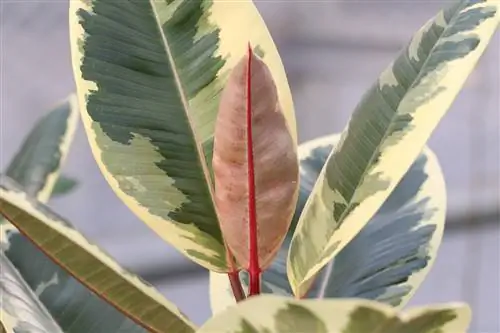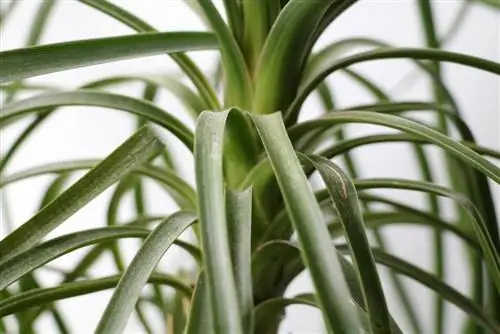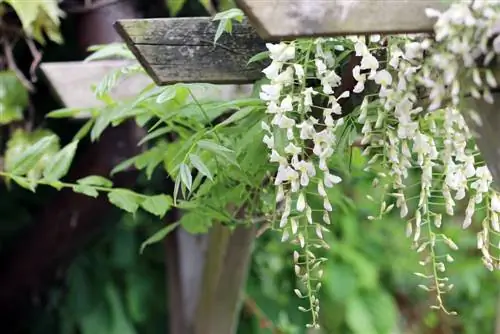- Author admin [email protected].
- Public 2023-12-17 03:39.
- Last modified 2025-01-24 12:45.
For many people, the rubber tree, a species of plant from the fig genus, is a decorative houseplant. However, the leaves of the plant in particular contain a mild poison that causes he alth problems in children and pets. Skin contact is enough to cause an allergic reaction. Therefore, choose a location that is inaccessible to children and animals.
Different species and their toxicity
The decorative rubber trees adorn the windows of many households. Alternatively, the plants known as fig trees decorate the rooms. The easy-care Ficus elastica with its thick, dark green leaves belongs to the mulberry family. Other representatives of the plant species can also be used as houseplants:
- Ficus benjamina
- Ficus pumila
- Ficus lyrata
- Ficus palmeri
The rubber tree is slightly toxic. If your children come into contact with the rubber tree sap, they will initially experience slight irritation of the mucous membrane. Pure skin contact leads to an allergic reaction, which often manifests itself in redness or skin irritation. If you wash the affected areas with lukewarm water, the unpleasant symptoms will disappear within a short time.
Small children in particular are fascinated by the thick leaves and they bite into them. The bad taste causes them to spit out reflexively. Nevertheless, the plant milk may reach the oral mucosa and then into the organism. As a result, the child suffers from unpleasant symptoms of illness:
- Gastrointestinal upset and vomiting as typical symptoms of poisoning
- The body reacts to plant toxins with diarrhea
- There is a risk of cramps and paralysis if large amounts of the leaves are consumed.
Tip:
If your child takes a bite from the rubber tree, dilute the toxins ingested with lukewarm drinks. Tea or water are suitable for this, never milk. Do not encourage your offspring to vomit, otherwise there is a risk of severe mucous membrane irritation.
As a rule, pets react more strongly to the plant's toxin than children. Oral intake also leads to stomach upset and vomiting. Place the Ficus elastica in a place that is difficult for children, cats and dogs to reach, to avoid poisoning with its consequences.
Symptoms of poisoning in babies

As soon as babies crawl, they can easily reach a rubber tree standing on the ground. Due to its long branches, the broad leaves often reach down to the ground. If your offspring touches the leaf surface, red spots quickly form on the sensitive skin. The unpleasant itching causes babies and small children to cry, so you should notice and contain the danger posed by the Ficus elastica in good time.
If the child touches the dark green foliage, he or she will pull it or break it off. The thick structure makes the sheet feel similar to a rubber toy. When the plant is torn, its white milky sap comes out. The leaves of the rubber tree also contain:
- Rubber
- Grow
- Cumarine
- Chlorogenic acid
The latter is a slightly poisonous substance that occurs in numerous plants. In your baby's system, it causes severe stomach upset, diarrhea and cramps. The severity of the symptoms depends largely on the amount consumed. For children under two years of age, a small dose is enough to cause he alth problems. Therefore, if you suspect rubber tree poisoning, consult your pediatrician. In addition to the foliage, the bark of the fig tree has toxic components. This includes, for example, tannic acid. If this gets into the toddler's mouth in large quantities, it causes stomach pain and vomiting. In addition, it is suspected of causing cancer.
If your offspring snacks on the bark of the rubber tree once, you usually don't need to worry about any complications. The flowers and fruits of the Ficus elastica look inconspicuous, but have a special effect on children. They pick off the fig-like, small parts of the plant and put them in their mouths. If there is a rubber tree in your home, consider the following:
- Leaves also contain toxins
- Toxic components in young shoots are stronger than in the leaves
- Oral ingestion of green beads dangerous to children's he alth
- Leads to severe abdominal pain and nausea
The flowers of the rubber tree are not characterized by their scent or color. Nevertheless, your offspring may find them interesting. Since they are also slightly poisonous plant elements, there is a risk of he alth-damaging complications if consumed. Although the fig tree rarely blooms in the apartment, it is still a good idea to collect the flowers in good time. Wear gloves when doing this to avoid skin irritation. A better alternative is to place the tree on a stool or sideboard. This prevents babies and children from getting close to the foliage, fruit and flowers.
Toxins in the plant parts
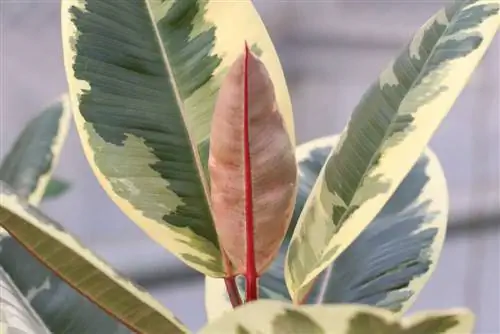
Ficus elastica contains a number of toxins. These are particularly dangerous for small children and babies. If your offspring puts the leaves or bark of the rubber tree in their mouths, it helps to rinse them out first. Activated charcoal also works in cases of oral poisoning. Plant substances that have a negative impact on human physiology include furocuramines. In addition to mulberry plants, the secondary plant substances are also found in citrus plants. They serve to ward off diseases and pests.
- If furocuramines get on the surface of the skin, burn-like symptoms occur
- If sunlight hits the epidermis at the same time, pain occurs
- Poisoning reaction depends on skin sensitivity
- Mild skin rash to painful burning as typical signs
- Stinging red skin irritations in small children
Flavonoids are also secondary plant substances. The substances exist in all ornamental and useful plants to protect them from predators. They only enter the body through food. If your offspring puts the leaves of the Ficus elastica or its milky juice in their mouths, the plant substances will cause their stomach to rumble. In large quantities - for example when eating several leaves - they can cause severe stomach pain and vomiting.
Children do not find the rubber tree tasty. You take a maximum of one bite of the seductively shiny leaf. Another ingredient in the fig tree is rubber. It owes its popular name, rubber tree, to him. The substance may cause allergic reactions if touched. People with a latex allergy in particular use gloves when caring for the plant to prevent skin contact. The following allergy reactions occur in small children:
- Skin redness
- Itching
- Squamation of the epidermis
- Anaphylactic shock
Protection from toxicity
The Ficus elastica is one of the slightly poisonous houseplants. However, families with children do not have to forego its decorative appearance in the home. So that the offspring do not come into contact with the bark and hanging leaves, place the rubber tree out of the reach of babies and children.
- Small specimens of the plant can easily fit on a cupboard
- A safe option is also to have a lockable winter garden
- Place the ornamental plant in the home study and prohibit the child from accessing it
This will prevent curious children's hands from examining the fig tree. If your rubber tree is in a room that the child also frequents, collect falling leaves as soon as possible. Otherwise, invite your little one to play and try things out. Do not touch the foliage with unprotected hands in direct sunlight. It is also recommended to wear long-sleeved clothing and gloves when caring for the plant.
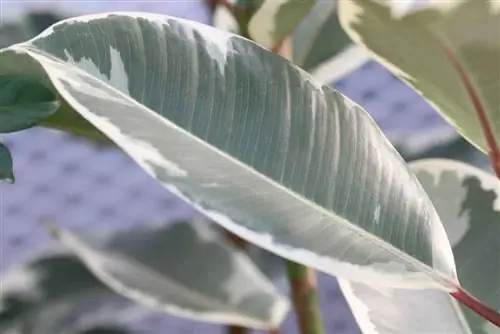
In rare cases, the milky sap squirts when the leaves are cut off. Therefore, do not work on the plant while your offspring are nearby. If the plant sap gets on your clothes, they should be put in the laundry. Otherwise your baby or child will come into contact with the allergenic substance in this detour.


